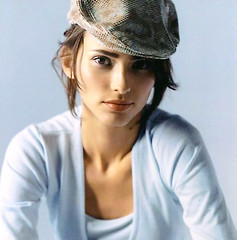
While browsing for Aimee Mann on the QuickTime site, I noticed that they now have technology that can let you play videos on on your mobile telephone. And mobiles have become so small these days that I keep opening my compact and holding it up to my hear after scrambling through my bag to answer an incoming call. I should either get a phone that doesn't have to flip open, or pressed powder that comes in a brick. As I tell everyone, I'm an old soul, and when I was at school I enjoyed all the parts that have nothing to do with my job in the media now, like taking movies on Super 8 and threading it through a projector. The videophones began their popularity in Japan, apparently, because they have long commutes to work on crowded subway compartments, and what better way to annoy your fellow travellers than to play an action movie on a little screen held up to their face while the person beside you is trying to compose a haiku? The space needed to set up a projector and play a flickering seven-minute reel would take up as much space as the entire compartment. I personally went through the transition from the whole plane of passengers on a transcontinental flight all craning their heads to watch the same movie and listening to the sound through stethoscopes, to everyone peering intently at the back of the seat in front of them surfing through various channels and having the film paused at a crucial point in the plot by an annoucement for turbulence.
On the same site, I downloaded the trailer for Kingdom of Heaven. Have you noticed that the more important the release is, the more elongated it gets? Really high-budget films seem to be shot in a strange format that requires you to swivel your head from one side to another if you're sitting in the cheap seats up front. Panavision now makes an 80mm format, which is ten times the width of the Kodachrome that I used in my father's Bolex. (I really should dig that up and shoot an epic-like script on it using sock puppets.)
Nothing is medium-sized anymore. Although, actually, they still are. We still are most accustomed to 4:3, the television format: count the number of hours you spend watching TV to watching extremely elongated movies about war and death in a theatre. Or staring at a computer monitor, for that matter. And when they shoot movies in various degrees of elongatedness, they still make sure that everything important happens in the middle, because at some point it's going to be on HBO. One theory is that a wide format is what we're more naturally inclined to, because our eyes are in roughly that proportion. Another theory is that we the wider the screen, the more we're in "surround" mode, and hence it's more real. Myself, I'd rather that it not be too wide so that I can use my peripheral vision to look out for pickpockets, stalkers, and shady would-be rapists lurking by the "Exit" signs.
The irony of it all was that when I finally managed to download the trailer and watch it (and I'm too impatient to click on the full-screen version to buffer), I had a gloriously large, wide-screen HD editing monitor in front of me, and it was completely black except for a a few dead pixels and a rectangle the size of a matchbox in the middle, on which was playing (with black bars above and below), the preview to the epic. I think that at some point in history, these were called peep-hole theatres.
What Filmed in Panavision Means

1 comment:
Good blog! ^^
Post a Comment